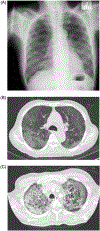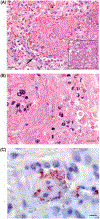Update on the diagnosis and treatment of Pneumocystis pneumonia
- PMID: 20736243
- PMCID: PMC6886706
- DOI: 10.1177/1753465810380102
Update on the diagnosis and treatment of Pneumocystis pneumonia
Abstract
Pneumocystis is an opportunistic fungal pathogen that causes an often-lethal pneumonia in immunocompromised hosts. Although the organism was discovered in the early 1900s, the first cases of Pneumocystis pneumonia in humans were initially recognized in Central Europe after the Second World War in premature and malnourished infants. This unusual lung infection was known as plasma cellular interstitial pneumonitis of the newborn, and was characterized by severe respiratory distress and cyanosis with little or no fever and no pathognomic physical signs. At that time, only anecdotal cases were reported in adults and usually these patients had a baseline malignancy that led to a malnourished state. In the 1960-1970s additional cases were described in adults and children with hematological malignancies, but Pneumocystis pneumonia was still considered a rare disease. However, in the 1980s, with the onset of the HIV epidemic, Pneumocystis prevalence increased dramatically and became widely recognized as an opportunistic infection that caused potentially life-treating pneumonia in patients with impaired immunity. During this time period, prophylaxis against this organism was more generally instituted in high-risk patients. In the 1990s, with widespread use of prophylaxis and the initiation of highly active antiretroviral therapy (HAART) in the treatment of HIV-infected patients, the number of cases in this specific population decreased. However, Pneumocystis pneumonia still remains an important cause of severe pneumonia in patients with HIV infection and is still considered a principal AIDS-defining illness. Despite the decreased number of cases among HIV-infected patients over the past decade, Pneumocystis pneumonia continues to be a serious problem in immunodeficient patients with other immunosuppressive conditions. This is mostly due to increased use of immunosuppressive medications to treat patients with autoimmune diseases, following bone marrow and solid organ transplantation, and in patients with hematological and solid malignancies. Patients with hematologic disorders and solid organ and hematopoietic stem cell transplantation are currently the most vulnerable groups at risk for developing this infection. However, any patient with an impaired immunity, such as those receiving moderate doses of oral steroids for greater than 4 weeks or those receiving other immunosuppressive medications are at also at significant risk.
Conflict of interest statement
Conflict of interest statement
AH Limper holds a US patent on a
Figures



References
-
- Aliouat-Denis CM, Chabe M, Demanche C, Aliouat el M, Viscogliosi E, Guillot J et al. (2008) Pneumocystis species, co-evolution and pathogenic power. Infect Genet Evol 8: 708–726. - PubMed
-
- Alvarez-Martinez MJ, Miro JM, Valls ME, Moreno A, Rivas PV, Sole M et al. (2006) Sensitivity and specificity of nested and real-time PCR for the detection of Pneumocystis jiroveci in clinical specimens. Diagn Microbiol Infect Dis 56: 153–160. - PubMed
-
- Annaloro C, Della Volpe A, Usardi P and Lambertenghi Deliliers G (2006) Caspofungin treatment of Pneumocystis pneumonia during conditioning for bone marrow transplantation. Eur Ɉ Clin Microbiol Infect Dis 25: 52–54. - PubMed
-
- Arcenas RC, Uhl JR, Buckwalter SP, Limper AH, Crino D, Roberts GD et al. (2006) A real-time polymerase chain reaction assay for detection of Pneumocystis from bronchoalveolar lavage fluid. Diagn Microbiol Infect Dis 54: 169–175. - PubMed
Publication types
MeSH terms
Grants and funding
LinkOut - more resources
Full Text Sources
Other Literature Sources
Miscellaneous

